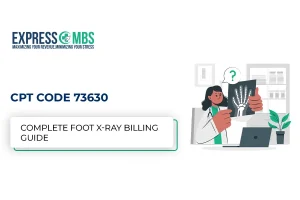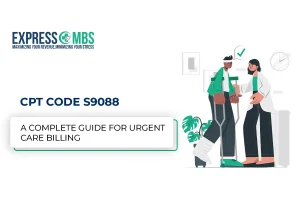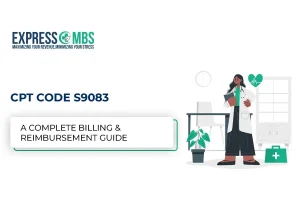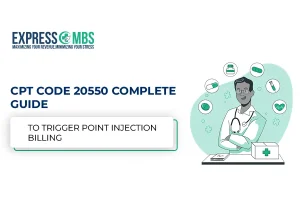
How to Bill and Document CPT Code 97597 Correctly

If you work in wound care or handle medical billing for a provider, you’ve likely come across the 97597 CPT code. But ensure you completely understand how to use it correctly? You’re not alone, this is one of the most frequently misunderstood codes in wound care billing.
At Express Medical Billing Services, we’ve helped countless clinics reduce denials and streamline reimbursements by mastering the nuances of wound debridement CPT codes like 97597, 97598, and 11042. In this guide, we’ll walk you through everything you need to know, including documentation tips, modifier use, RVUs, and how to avoid costly errors.
What Is CPT Code 97597?
The 97597 CPT code is used to explosion selective debridement of exposed wounds. This includes the removal of non-viable tissue such as necrotic epidermis, dermis, and fibrin using tools like scissors, scalpels, forceps, and high-pressure waterjet.
Unlike excisional debridement (billed under CPT 11042), selective debridement targets only devitalized tissue and spares healthy structures. It’s a conservative yet essential approach in wound healing.
97597 CPT Code Description
- Debridement of non-viable tissue
- Topical applications to aid wound healing
- Wound assessment (size, depth, drainage, tissue status)
- Patient instructions for ongoing care
- Whirlpool therapy may be included when it’s part of the debridement procedure.
When to Use CPT Code 97597 vs. 97598
- CPT 97597 is appropriate for wounds measuring up to 20 cm²
- CPT 97598 should be added for each additional 20 cm² beyond the initial area
For instance, if a wound actions 35 cm², bill 97597 + 97598 for the extra 15 cm².
CPT Code 97597 Place of Service
This code can be reported in multiple care settings:
- Physician’s office
- Hospital outpatient departments
- Skilled nursing facilities
- Home health care (with proper documentation)
Does CPT Code 97597 Need a Modifier?
Yes, depending on the circumstances, you might need to use modifiers like:
- Modifier -59: Indicates a distinct procedural service, often necessary when billing alongside CPT code 11042 to show that the procedures were separate.
- Modifier -25: Used when a significant, separately identifiable evaluation and management (E/M) service is provided on the same day as the procedure.
- Modifier -XU: When needed to indicate a separate anatomical site
Always check your payer’s Local Coverage Determination (LCD for CPT code 97597) to confirm specific rules.
Documentation Tips - Avoid Denials
Complete documentation is your best cover in contradiction of claim rejections. Here’s what to include:
- Wound size and location
- Pre- and post-debridement condition
- Debridement technique used
- Medical necessity for removing non-viable tissue
- Follow-up care or dressing application
- Notes about whirlpool therapy (if applicable)
Remember, if the documentation doesn’t clearly show selective debridement, your claim could be denied, or down coded to an E/M service.
97597 CPT Code RVU & Reimbursement
The RVU (Relative Value Unit) for 97597 can vary slightly by region and payer, but on average:
- Non-facility RVU: ~1.07
- Medicare reimbursement: Typically ranges from $37–$45 depending on locality
Check the CMS Physician Fee Schedule for the latest rates in your area.
CPT Code 97597 vs 11042 – What's the Difference?
Criteria | 97597 CPT Code | 11042 CPT Code |
Type of Debridement | Selective (non-excisional) | Excisional |
Depth | Epidermis/dermis | Subcutaneous tissue |
Tools Used | Scissors, scalpel, forceps | Scalpel for full excision |
Documentation Required | Less invasive, but detailed | More surgical, in-depth notes |
Common Use | Chronic wounds, diabetic ulcers | Deep infected wounds |
Providers often confuse the two, using 97597 when 11042 is warranted could lead to underpayment. Reversely, billing 11042 without surgical justification may trigger an audit.
Real-World Insight from Our Billing Team
Recently, we worked with a podiatry clinic billing 97597 and 97598 for multiple wound care visits. Their claims were repeatedly denied. After reviewing their documentation, we found that they weren’t noting wound surface area or debridement method—two key requirements.
Once we updated their charting process and added the correct modifiers, they saw a reimbursement increase of 20% and a 75% reduction in denials within just two months.
Best Practices for Billing CPT Code 97597
- Always document the exact wound size
- Indicate selective vs. excisional technique clearly
- Attach relevant modifiers when billing with other procedures
- Keep up with your Medicare LCD updates for CPT code 97597
- Train your staff on the difference between 97597 and 11042 CPT codes
Conclusion
Understanding how to correctly bill and document the 97597 CPT code can make a big difference in revenue and compliance. Whether you’re in wound care, podiatry, or general practice, accurate documentation, correct modifier usage and proper coding are crucial.
At Express Medical Billing Services, we specialize in helping healthcare providers navigate complex codes like 97597, 97598, and 11042 with confidence. Let us help you maximize reimbursements while minimizing denials.
Need help with wound care billing? Contact us today for expert support.
Frequently Asked Questions (FAQs)
It’s used for selective debridement of open wounds with non-viable tissue, up to 20 cm².
Yes, depending on the context, Modifier 59 is common when billed with other codes like 11042.
97597 covers non-excisional (selective) debridement. 11042 are for excisional (surgical) debridement to hypodermic tissue.
It has an average RVU of 1.07 and Medicare pays around $37–$45 based on locality.
Yes, report 97597 for the first 20 cm² of the wound, and add 97598 for each additional 20 cm² beyond that.



